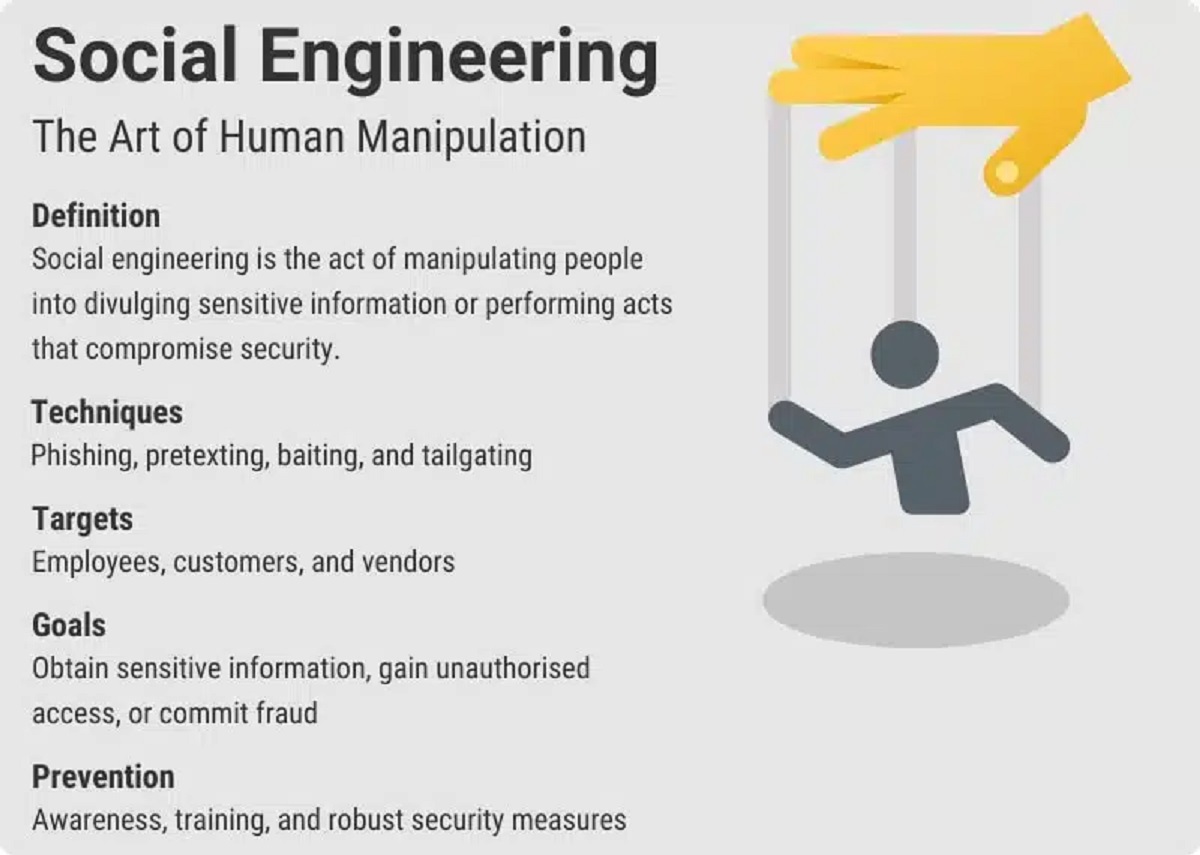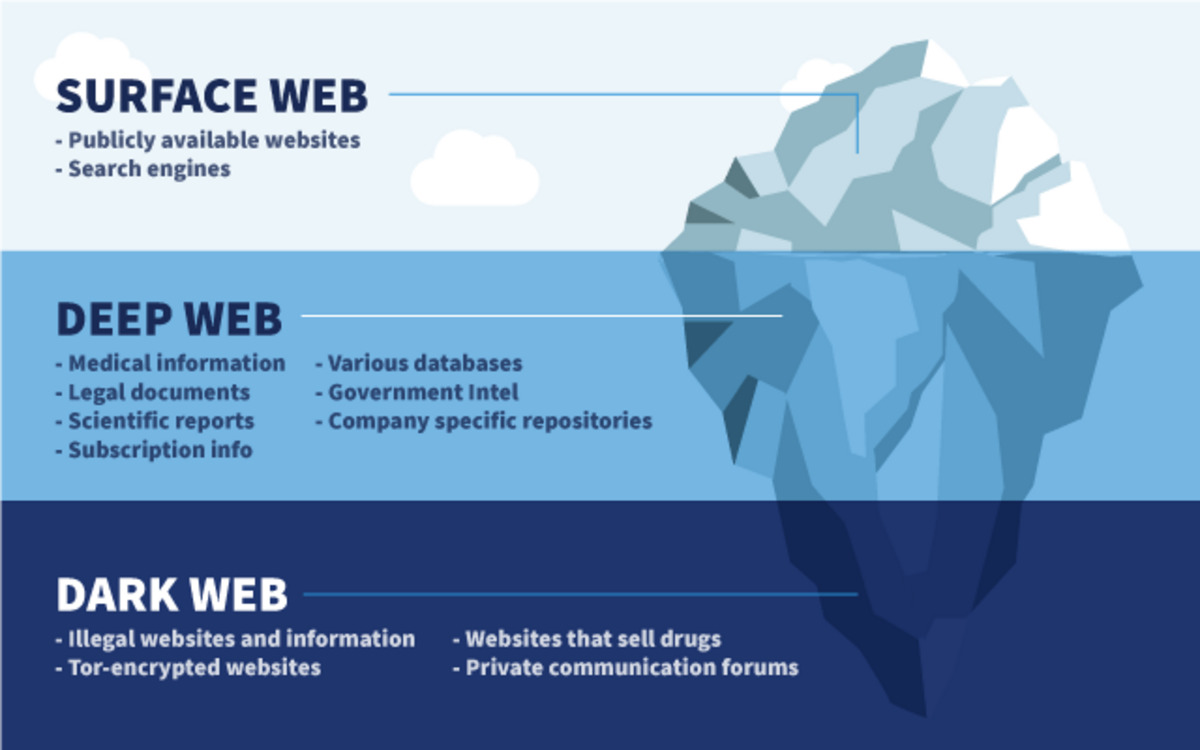Introduction
With the increasing presence of technology in our daily lives, the need for robust cybersecurity measures has never been more crucial. While we often think of cybersecurity as protection against hackers and malware, there is another equally formidable threat known as social engineering. Social engineering is a tactic used by cybercriminals to manipulate and deceive individuals into revealing sensitive information or performing actions that can compromise their security.
In today’s interconnected world, where personal and financial data is stored and transmitted online, social engineering attacks have become alarmingly prevalent. From phishing emails to phone scams, cybercriminals employ various techniques to exploit human vulnerabilities and manipulate individuals into unintentionally aiding their malicious schemes.
Understanding the concept of social engineering and its implications is key to fostering a culture of cybersecurity awareness and ensuring our personal and professional lives remain safeguarded. In this article, we will explore what social engineering is, its importance in the realm of cybersecurity, the various types of social engineering attacks, and how to protect ourselves from falling victim to these manipulative tactics.
What is Social Engineering?
Social engineering is a technique used by cybercriminals to exploit human psychology and manipulate individuals into divulging confidential information or performing actions that can compromise their security. Unlike other forms of cyber attacks that primarily target technical vulnerabilities, social engineering preys on human weaknesses and trust.
The main objective of social engineering is to gain unauthorized access to sensitive information, such as passwords, financial details, or other personal data, by using psychological manipulation rather than technical exploits. By impersonating trusted individuals or organizations, hackers effectively gain the trust of their victims, leading them to willingly provide access or divulge sensitive information that can be used for malicious purposes.
One of the reasons why social engineering is so effective is that it exploits common human emotions and behavioral traits such as trust, curiosity, fear, and compassion. Hackers leverage these emotions to deceive individuals and convince them to perform actions that they wouldn’t usually do under normal circumstances.
Examples of social engineering tactics include:
- Phishing: This involves sending mass emails or messages that appear to come from reputable organizations or individuals, tricking recipients into clicking on malicious links or providing personal information.
- Pretexting: In this type of attack, the hacker establishes a fake identity or scenario to gain the victim’s trust. For example, posing as a bank employee or IT technician to extract sensitive information.
- Tailgating: This technique involves an attacker physically following an authorized person into a restricted area or building, taking advantage of their trust and assuming their access privileges.
- Baiting: Hackers leave physical devices, such as a USB drive, in a public area and wait for unsuspecting individuals to pick them up. These drives are often infected with malware or designed to extract sensitive information when plugged into a computer.
It’s important to note that social engineering attacks are not limited to online interactions but can also occur through phone calls, in-person encounters, or even through social media platforms. Cybercriminals are constantly evolving their tactics to exploit new vulnerabilities and prey on unsuspecting individuals.
The Importance of Cybersecurity
In today’s digital age, where technology pervades every aspect of our lives, cybersecurity has become paramount. The increasing threat of cyber attacks poses serious risks to individuals, businesses, and society as a whole. The importance of cybersecurity cannot be overstated, as it is crucial for protecting sensitive information, preventing financial loss, maintaining privacy, and safeguarding national security.
One of the primary reasons why cybersecurity is vital is to protect personal information. We store a wealth of sensitive data, such as financial records, identification documents, and personal communications, on various online platforms. Without effective cybersecurity measures, this information becomes vulnerable to theft or unauthorized access. Cybercriminals can exploit this data for financial gain, identity theft, or engaging in fraudulent activities.
For businesses, cybersecurity is a critical aspect of maintaining trust and reputation. A single data breach can result in significant financial losses, damage to brand reputation, and loss of customers. Large-scale cyber attacks on organizations have made headlines in recent years, highlighting the dire consequences of inadequate cybersecurity measures. Businesses must invest in robust security protocols to protect customer data, intellectual property, and confidential business information.
Cybersecurity is also vital for maintaining privacy. With the proliferation of online platforms and social media, our personal lives have become more exposed than ever before. Without proper cybersecurity measures, our private conversations, photos, and personal information can be exploited or hijacked, leading to invasion of privacy and potential harm.
Furthermore, in the modern interconnected world, even national security is at stake. Cyber attacks can disrupt critical infrastructure systems, such as power grids, transportation systems, or communication networks, compromising public safety and causing widespread chaos. Governments and organizations need to prioritize cybersecurity to protect the nation’s vital systems and ensure the safety and well-being of its citizens.
Given the ever-evolving nature of cyber threats, it’s essential to stay vigilant and proactive in implementing robust cybersecurity practices. This includes regular software updates, installing strong passwords and two-factor authentication, educating employees and individuals about potential risks, and implementing effective security measures at both personal and organizational levels.
By prioritizing cybersecurity, we can ensure the safety and security of our digital lives, protect sensitive information, and build a resilient and secure digital landscape for the future.
Definition of Social Engineering
Social engineering refers to the manipulation and exploitation of human behavior and emotions to deceive individuals and gain unauthorized access to sensitive information or resources. Unlike other cybersecurity attacks that exploit technical vulnerabilities, social engineering attacks target the weakest link in any security system: humans.
At its core, social engineering relies on psychological manipulation and social interaction to trick individuals into divulging confidential information, performing actions that compromise their security, or giving unauthorized access to physical or digital assets. Hackers who employ social engineering tactics take advantage of human vulnerabilities, such as trust, fear, curiosity, or compassion, to manipulate their victims.
One of the defining characteristics of social engineering is the use of deception. Attackers often pose as someone they are not, impersonating trusted individuals or institutions, such as bank representatives, IT personnel, or government officials. They consistently refine their methods to make their fake personas appear legitimate, using tactics like creating fake websites, forging email addresses, or conducting thorough research on their victims to enhance their believability.
Social engineering attacks can take many forms, such as phishing emails, phone scams, baiting, pretexting, or even physical interactions like tailgating. The ultimate goal is to gain access to sensitive information, compromise systems, or manipulate individuals into performing actions that benefit the attacker.
It’s important to note that social engineering attacks are not limited to specific industries or individuals. They can target anyone, from individuals at home to employees within organizations, seeking to exploit their trust, curiosity, or ignorance to achieve their malicious objectives.
While social engineering attacks can have devastating consequences, they can also be difficult to detect because they exploit human nature and behavior rather than technical vulnerabilities. Therefore, it is important to be aware of the various techniques employed in social engineering attacks and to continually educate ourselves on how to identify and prevent falling victim to these manipulative tactics.
In the next sections, we will explore the different types of social engineering attacks, common techniques used by hackers, and ways to protect ourselves from these threats.
Types of Social Engineering
Social engineering attacks come in various forms, each targeting different aspects of human behavior and vulnerabilities. These attacks exploit our natural inclinations, such as trust, curiosity, fear, and compassion, to manipulate us into divulging sensitive information or performing actions that compromise our security. Understanding the different types of social engineering attacks can help in recognizing and thwarting these malicious tactics.
1. Phishing: Phishing is one of the most common types of social engineering attacks. It involves sending deceptive emails or messages that appear to come from reputable sources, such as banks, social media platforms, or government agencies. The goal is to trick recipients into providing personal information, such as passwords or credit card details, by clicking on malicious links or responding to the fraudulent communication.
2. Pretexting: Pretexting is a form of social engineering where attackers create a false pretext or scenario to gain the victim’s trust and extract sensitive information. This can involve posing as a service provider, IT support, or a colleague in need of assistance. The attacker uses these false identities to manipulate victims into revealing confidential data or providing access to systems or accounts.
3. Baiting: Baiting attacks rely on the curiosity of individuals. Attackers may leave physical devices, such as infected USB drives or enticing files, in public places where potential victims are likely to find them. Unsuspecting individuals who pick up and use these devices unknowingly compromise their systems by installing malware or unintentionally divulging sensitive information.
4. Tailgating: Tailgating, also known as piggybacking, takes advantage of the trust and politeness of individuals. In this type of attack, an unauthorized person follows a legitimate employee into a restricted area by appearing to be authorized or pretending to be a delivery person. By doing so, the attacker gains unauthorized access to secure areas, systems, or data.
5. Impersonation: Impersonation attacks involve pretending to be someone else to gain trust and gather sensitive information. This can include impersonating a company executive, a customer service representative, or a trusted acquaintance. By leveraging trust and authority, attackers manipulate victims into revealing confidential information or granting access to valuable resources.
6. Spear Phishing: Spear phishing is a targeted form of phishing that focuses on specific individuals or organizations. Attackers conduct extensive research to personalize their communication and make it appear highly credible and tailored to the target. By leveraging personal information, such as names, job titles, or affiliations, attackers increase the likelihood of their victims falling for their fraudulent messages.
These are just a few examples of the different types of social engineering attacks. Cybercriminals continually adapt and develop new tactics to exploit human psychology and weaknesses. By being aware of these techniques and educating ourselves about the risks, we can take proactive measures to protect ourselves and mitigate the potential damage caused by social engineering attacks.
Common Techniques Used in Social Engineering Attacks
Social engineering attacks employ various techniques to manipulate individuals and exploit their vulnerabilities. These techniques are designed to deceive and trick victims into divulging sensitive information, granting unauthorized access, or performing actions that compromise their security. Understanding these common techniques can help individuals and organizations be better prepared to identify and defend against social engineering attacks.
1. Manipulative Emails: Phishing emails are a prevalent social engineering technique. Attackers craft convincing emails that appear to come from trusted sources, such as banks or popular online platforms. These emails often contain urgent requests or alarming messages, compelling recipients to click on malicious links or provide personal information. By masquerading as legitimate entities, attackers exploit the trust users have in these organizations to convince them to take action.
2. Impersonation: Impersonation is a technique where attackers pose as someone else to gain trust and gather sensitive information. This can involve impersonating colleagues, service providers, or even authority figures like police officers or government officials. By leveraging trust and authority, the attacker manipulates victims into revealing confidential information or granting access to valuable resources.
3. Phone-Based Attacks: Social engineering also extends to phone-based attacks. Attackers may impersonate legitimate individuals or organizations and contact victims to deceive them. Techniques like vishing (voice phishing) involve phone calls that trick victims into providing personal information or performing actions that help the attacker. These attacks exploit the trust and often catch victims off guard, leading them to fall into the trap.
4. Social Media Exploitation: Social media platforms provide a wealth of personal information that attackers can exploit. They use this information to craft targeted messages and gain the trust of their victims. Attackers may create fake profiles or impersonate individuals to trick users into sharing personal information or clicking on malicious links. By manipulating victims’ online connections and exploiting their trust in social media platforms, attackers can extract sensitive data and perpetrate their scams.
5. Manipulative Persuasion: Social engineering attacks often involve manipulative persuasion techniques to influence victims to comply with the attacker’s requests. These techniques exploit human emotions like fear, curiosity, or excitement. Attackers create a sense of urgency or induce curiosity through tailored messages, compelling victims to take immediate action without considering the potential risks.
6. Physical Impersonation: In some cases, social engineering attacks occur in person. Attackers may dress or act in a way that resembles authorized personnel, allowing them to gain access to restricted areas or systems. By exploiting social norms and trust, they manipulate individuals into granting access or providing information that compromises security measures.
It’s important to understand that social engineering attacks combine these techniques to maximize their effectiveness. Attackers are constantly evolving their tactics, using psychological manipulation and detailed research to tailor their approaches to individual targets. Being aware of these techniques and maintaining a healthy skepticism can help individuals and organizations better protect themselves against social engineering attacks.
How to Protect Yourself from Social Engineering Attacks
Protecting yourself from social engineering attacks requires a combination of vigilance, awareness, and proactive measures. By following these guidelines, you can significantly reduce the risk of falling victim to these manipulative tactics:
1. Develop a Security Mindset: Cultivate a mindset of skepticism when it comes to unsolicited requests or opportunities that seem too good to be true. Be wary of messages that manipulate emotions or create a sense of urgency. Treat any unexpected communication, whether via email, phone call, or social media, with caution and verify its authenticity before taking any action.
2. Stay Informed: Stay up-to-date with the latest social engineering techniques and common scams. Educate yourself about the various types of attacks to recognize warning signs and red flags. Regularly check reliable resources and cybersecurity websites to stay informed about emerging threats and best practices for protection.
3. Be Mindful of Information Sharing: Be cautious about sharing personal or sensitive information, especially in response to unsolicited requests. Legitimate organizations will rarely ask for sensitive information via emails or messages. If in doubt, reach out to the organization directly through their official channels to verify the authenticity of the request.
4. Implement Strong Password Practices: Use strong, unique passwords for every online account you have. Avoid using easily guessable passwords or personal information that can be easily obtained or guessed. Enable multi-factor authentication whenever possible to add an extra layer of security to your accounts.
5. Think Before You Click: Exercise caution when clicking on links, downloading files, or opening email attachments. Hover over links to check their destination before clicking. If something seems suspicious or out of the ordinary, refrain from clicking or opening it. Use reputable and up-to-date antivirus software to detect and prevent malware infections.
6. Regularly Update Software: Keep your devices and software up-to-date with the latest security patches and updates. Many updates contain bug fixes and security enhancements that can protect against known vulnerabilities exploited by attackers.
7. Be Wary of Social Media: Be mindful of what you share on social media platforms. Limit the personal information you post and customize privacy settings to control who can view your posts and profile. Be cautious when accepting friend requests from strangers or clicking on links shared through social media platforms.
8. Practice Physical Security: Protect physical devices such as laptops, smartphones, and USB drives to prevent unauthorized access. Lock your devices when not in use and be mindful of your surroundings to minimize the risk of someone physically accessing your information without your knowledge.
9. Stay Educated: Engage in regular cybersecurity awareness training to stay updated on the latest threats and best practices. Organizations should provide training and resources for employees to enhance their understanding of social engineering risks and how to detect and respond to them.
By incorporating these practices into your daily routine, you can significantly reduce the risk of falling victim to social engineering attacks. Remember, staying informed and vigilant is paramount in protecting yourself from these manipulative tactics.
Examples of Social Engineering in Action
Social engineering attacks can take various forms, and real-life examples highlight the effectiveness of these manipulative tactics. Understanding these examples can help individuals and organizations recognize the signs of social engineering and take necessary precautions to protect themselves:
1. Phishing Emails: One common example is phishing emails that appear to come from reputable organizations like banks or online platforms. The email may ask recipients to click on a link and provide their login credentials or personal information. Unsuspecting victims who fall for this trap unknowingly hand over their sensitive information to attackers who can then exploit it for financial gain or identity theft.
2. CEO Fraud: In this type of attack, cybercriminals pose as company executives and send urgent emails to employees in the finance or HR departments. The email requests a wire transfer to a specific account, making it seem like a legitimate request. Employees who do not verify the authenticity of the request may fall for this scam, transferring funds directly into the attacker’s account.
3. Tech Support Scams: Attackers may call unsuspecting individuals, claiming to be from a reputable tech support company. They convince the victim that there is an issue with their computer or network and request remote access to fix it. Once granted access, the attacker can install malware, steal personal information, or extort money from the victim.
4. Impersonating Government Agencies: Scammers may pose as government officials and contact individuals through phone calls or emails. They claim there is a problem with the individual’s taxes, immigration status, or other official matters. To resolve the issue, victims are coerced into providing personal information or making payments to the scammer, who is not actually affiliated with any government agency.
5. USB Dropping: In this physical social engineering tactic, an attacker strategically leaves a USB drive in a public place, such as a parking lot or office building. The USB drive may be labeled as “confidential” or contain intriguing files. Curious individuals who find the drive may plug it into their computer, unknowingly installing malware or allowing the attacker to gain remote access to their system.
6. Fake Sweepstakes or Lottery Winnings: Scammers may contact individuals claiming that they have won a large sum of money in a sweepstakes or lottery, despite the individual not entering any such contest. To claim the winnings, the victim is asked to provide personal information, pay processing fees, or share banking details. This results in financial loss and potential identity theft for the victim.
7. Tailgating: Attackers may gain unauthorized access to secured facilities by following an authorized employee through locked doors or access points. By using social engineering techniques, such as pretending to be on an urgent phone call or carrying multiple items, the attacker exploits the trust and politeness of employees, bypassing security measures without suspicion.
These examples illustrate the diverse nature of social engineering attacks and how they exploit human vulnerabilities. By being aware of these tactics and staying vigilant, individuals and organizations can better protect themselves from falling victim to these manipulative schemes.
Conclusion
Social engineering attacks pose a significant threat in today’s digital landscape. Cybercriminals exploit human vulnerabilities, trust, and emotions to manipulate individuals into divulging sensitive information, granting unauthorized access, or performing actions that compromise their security. The examples and techniques discussed in this article demonstrate the diverse methods employed by attackers to deceive their victims.
Understanding social engineering and its various forms is crucial for individuals and organizations to enhance their cybersecurity practices. By adopting a security mindset, staying informed about the latest threats, and implementing proactive measures, individuals can significantly reduce the risk of falling victim to social engineering attacks.
Education and awareness are key in combatting social engineering. Regular training and awareness programs can equip individuals with the knowledge and skills needed to identify and respond effectively to social engineering tactics. By fostering a culture of cybersecurity and cultivating a healthy skepticism, individuals can better protect themselves and their organizations from these manipulative tactics.
It is also important for organizations to implement robust security protocols, including strong password policies, regular software updates, and employee training. By investing in cybersecurity measures, organizations can strengthen their defenses against social engineering attacks and reduce the likelihood of a successful breach.
In an ever-evolving digital landscape, staying vigilant and proactive is necessary to counter the constant threat of social engineering attacks. By remaining informed, adapting security practices, and fostering a culture of cybersecurity, individuals and organizations can mitigate the risks, protect sensitive information, and maintain a secure online environment.

























